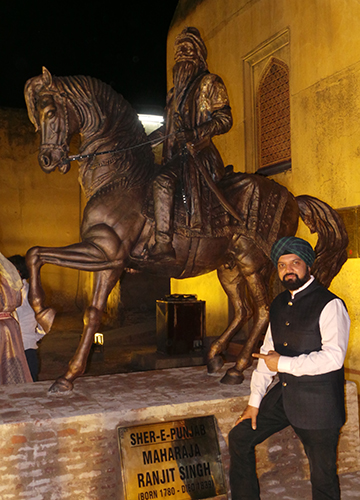Growing up in England, I knew nothing about Sikhism. I did not know where we came from, who we were, and why we wore the turban—till 1984 happened, which was an eye-opener.
Back then, a friend shared a magazine with me. Two images on it struck me. One was of Sher-e-Punjab Maharaja Ranjit Singh, and, the other, a prince in exile—Maharaja Duleep Singh. As I started reading the magazine, I discovered there was a Sikh empire. I also discovered that just two hours from my house was the place where Duleep Singh was buried, in Eleveden Church. I knew nothing about it.
During the weekend I told a friend who stayed close to the church, “Do you know there is a prince buried right next to your house?” I looked at the graveyard and his house.
In six weeks I ended up in Lahore. I sat on a tonga and took a ride around the city. I saw the Lahore fort. The view was so imposing that it was embedded in my brain. After that I saw the samadhi of Ranjit Singh in Lahore. I also visited the Sikh gallery. That was the beginning. From then, the more I read about Sikh generals and empires, the more fascinated I was.
Back in the 1980s and 1990s everybody was looking for a role model. And we [Sikhs] were fortunate to have Duleep Singh. We had an attachment towards Duleep Singh and Ranjit Singh. For us, they were kings. A lot of Sikh organisations in Great Britain talk about the repatriation of Duleep Singh. But, many, like me, do not want him to be repatriated. His body was to be exhumed and sent to India but at the end of the day, he was born in Lahore. He had nothing to do with Amritsar.
Once a Pakistani ambassador said to me that they have got a legal claim on Duleep Singh, and hence his body should be brought back to Lahore. This is the same case with the Koh-i-Noor. Where did the Koh-i-Noor come from? How did Ranjit Singh acquire it? My view is that the Koh-i-Noor should be repatriated to the Golden Temple, the spiritual capital of Sikhs. Ranjit Singh was in Amritsar. All his treasures were stored in Gobindgarh Fort. Ranjit Singh donated so much gold to the Golden Temple because he wanted Amritsar to have its own importance.
I do not think India has done enough to bring back the Koh-i-Noor. I do not think India wants to spoil its relationship with Great Britain. I also do not think that Sikhs have done enough. I do not think that there is not enough unity (among Sikhs) at the moment.
The Koh-i-Noor belonged to the people. Ranjit Singh wore it at state functions, only to impress the British and the foreigners. Otherwise it was lying around in the fort.
Also read
- India has not done enough to bring back Koh-i-Noor: Geoffrey Robertson
- Why it is difficult for India to reclaim Koh-i-Noor
- Can India bring back artefacts looted before independence?
- How a forgetful British civil servant nearly lost Koh-i-Noor
- India seeks to reclaim Koh-i-Noor, the world's most famous diamond
- University of Aberdeen leads the way in returning artefacts to their rightful heirs
The golden throne of Ranjit Singh is in the Victoria and Albert Museum in London. Mind you, nobody ever dares to sit on that chair, because it feels that Ranjit Singh is still there. That is how powerful it is. Same is the case with the Koh-i-Noor. When you move past it and look at it for a few seconds, there is some kind of vibration you feel; a feeling that it is alive. People do not want to give up such symbolic relics because there is some kind of magic behind it. I cannot express it in words. It is like a magnet that draws you in.
The British tricked Duleep Singh. He was compelled to give up the Koh-i-Noor. It was a treaty that he did not understand. He did not understand the clauses. Duleep Singh put his thumbprint on something that he did not comprehend.
Bansal is a councillor in Leicestershire, UK. He has written four books on Maharaja Ranjit Singh. His latest book is The Punjab Chiefs: The Lost Glory of The Punjab Aristocracy in India and Pakistan.


